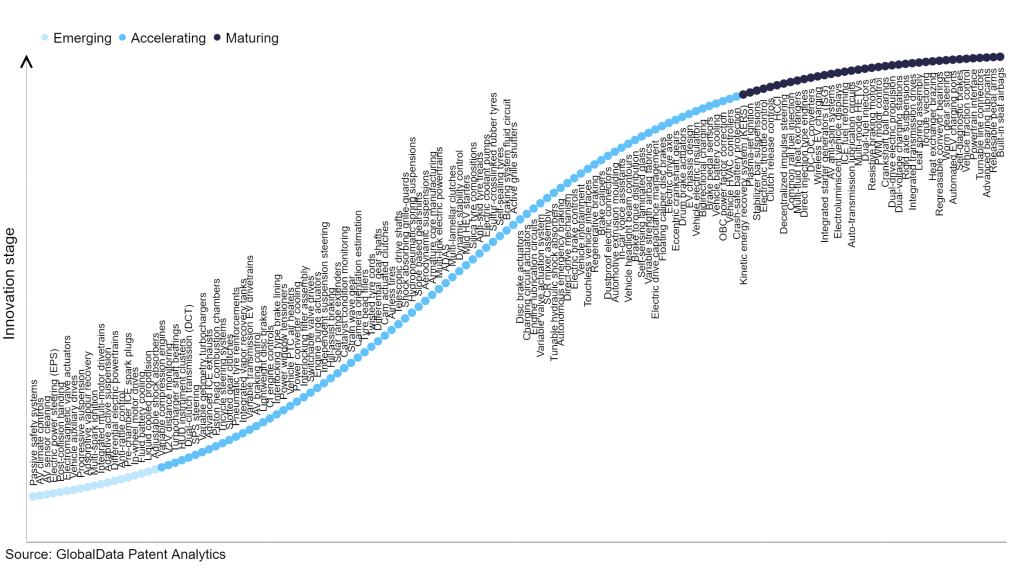The automotive industry continues to be a hotbed of patent innovation. Activity is driven by the demand for connected vehicles and real-time tracking systems and urgent need for road vehicle safety systems, and growing importance of technologies such as friction braking and electromechanical braking. In the last three years alone, there have been over 1.7 million patents filed and granted in the automotive industry, according to GlobalData’s report on Innovation in automotive: disc brake actuators. Buy the report here.
However, not all innovations are equal, and nor do they follow a constant upward trend. Instead, their evolution takes the form of an S-shaped curve that reflects their typical lifecycle from early emergence to accelerating adoption, before finally stabilizing and reaching maturity.
Identifying where a particular innovation is on this journey, especially those that are in the emerging and accelerating stages, is essential for understanding their current level of adoption and the likely future trajectory and impact they will have.
300+ innovations will shape the automotive industry
According to GlobalData’s Technology Foresight, which plots the S-curve for the automotive industry using innovation intensity models built on over one million patents, there are 300+ innovation areas that will shape the future of the industry.
Within the emerging innovation stage, integrated multi-motor drivetrains, electric power steering (EPS), and post-collision handing are useful technologies that are in the early stages of wider application and should be tracked closely. Variable compression engines, V2V distance monitoring, and turbocharger shaft bearings are some of the accelerating innovation areas, where adoption has been steadily increasing. Among maturing innovation areas are kinetic energy recovery system (KERS) and plasma-jet ignition, which are now well-established in the industry.
Innovation S-curve for the automotive industry

Disc brake actuators is a key innovation area in Automotive
Brake actuators and diaphragm actuators are key components of a braking system as they convert the pressure exerted on the brake pedal into braking force. Diaphragm actuators ensure that the pressure generated is applied on the brake calipers, thereby pressing the brake pads against the brake discs.
GlobalData’s analysis also uncovers the companies at the forefront of each innovation area and assesses the potential reach and impact of their patenting activity across different applications and geographies. According to GlobalData, there are 20+ companies, spanning technology vendors, established automotive companies, and up-and-coming start-ups engaged in the development and application of disc brake actuators.
Key players in disc brake actuators – a disruptive innovation in the automotive industry
‘Application diversity’ measures the number of applications identified for each patent. It broadly splits companies into either ‘niche’ or ‘diversified’ innovators.
‘Geographic reach’ refers to the number of countries each patent is registered in. It reflects the breadth of geographic application intended, ranging from ‘global’ to ‘local’.
Patent volumes related to disc brake actuators
Source: GlobalData Patent Analytics
Hitachi is the top patent filer in the disc brake actuators innovation area. The company has manufactured new automotive disc brake pad set and is developing three electronic control technologies for chassis subsystems to improve safety, security, and comfort in the era of autonomous driving. For the brakes, an electro-mechanical brake (“Smart Brake”) is being developed that is expected to improve vehicle safety and economy using brake-by-wire for high responsiveness and precise control. HL Mando, Stella Vermogensverwaltungs, NTT, and Zeppelin-Stiftung are the other major patent filers in disc brake actuators.
In terms of application diversity, Keyang Electric Machinery held the top position, while JTEKT and COSCO stood in second and third positions, respectively. By means of geographic reach, Safran leads the pack, followed by JTEKT and Toyota Motor.
To further understand the key themes and technologies disrupting the automotive industry, access GlobalData’s latest thematic research report on Automotive.
Data Insights
From

The gold standard of business intelligence.
Blending expert knowledge with cutting-edge technology, GlobalData’s unrivalled proprietary data will enable you to decode what’s happening in your market. You can make better informed decisions and gain a future-proof advantage over your competitors.







